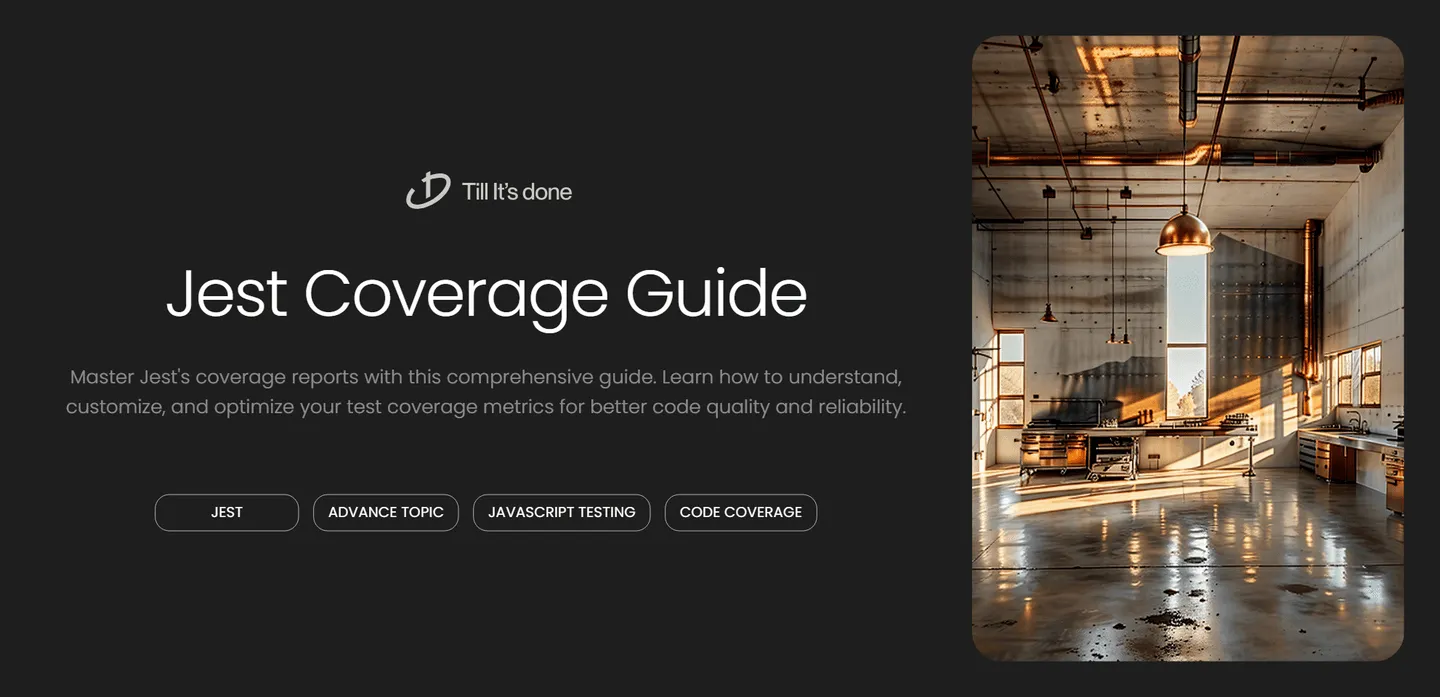- Services
- Case Studies
- Technologies
- NextJs development
- Flutter development
- NodeJs development
- ReactJs development
- About
- Contact
- Tools
- Blogs
- FAQ
Jest's Coverage Reports: Complete Guide 2024
Learn how to understand, customize, and optimize your test coverage metrics for better code quality and reliability.


Jest’s Coverage Reports: Understanding and Customizing
If you’ve been working with Jest for a while, you might have noticed those colorful reports that pop up after your tests run. These aren’t just pretty numbers – they’re your coverage reports, and they’re absolutely crucial for understanding how thoroughly your code is being tested.
What Are Coverage Reports?
Coverage reports are like your code’s health checkup results. They tell you exactly which parts of your code were executed during your tests and, more importantly, which parts weren’t. This information is invaluable for maintaining code quality and identifying potential blind spots in your testing strategy.

Understanding Coverage Metrics
Jest breaks down coverage into four key metrics:
Statements Coverage
This shows you what percentage of your code statements were executed. Think of statements as the individual instructions in your code – every line that does something.
Branches Coverage
This metric reveals how many of your code’s decision points (if/else statements, ternary operators, etc.) have been tested. It’s particularly important because it helps ensure you’re testing both the “happy path” and edge cases.
Functions Coverage
As you might guess, this tells you what percentage of your functions were called during testing. It’s a great way to spot any forgotten utility functions or helpers that might need attention.
Lines Coverage
This is the simplest metric to understand – it shows which lines of code were executed during your tests.
Customizing Your Coverage Reports

Let’s dive into how you can make these reports work better for your specific needs. Here’s how to customize your Jest coverage configuration in your package.json or jest.config.js:
{ "jest": { "coverageThreshold": { "global": { "branches": 80, "functions": 80, "lines": 80, "statements": 80 } }, "collectCoverageFrom": [ "src/**/*.{js,jsx}", "!src/**/*.test.{js,jsx}", "!src/index.js" ], "coverageReporters": ["text", "html", "lcov"] }}Key Customization Options:
-
Coverage Thresholds: Set minimum coverage requirements for your project. If coverage falls below these thresholds, Jest will fail the tests.
-
Collection Patterns: Specify which files to include or exclude from coverage reports using
collectCoverageFrom. -
Report Formats: Choose from various report formats like text, HTML, or LCOV using
coverageReporters.
Best Practices
- Start with realistic coverage goals - 100% coverage isn’t always necessary or practical
- Focus on critical business logic first
- Use coverage reports as a guide, not a gospel
- Regularly review and update your coverage thresholds as your project evolves
Common Pitfalls to Avoid
- Don’t obsess over reaching 100% coverage
- Remember that high coverage doesn’t guarantee high-quality tests
- Be careful not to write tests just to increase coverage numbers
- Don’t ignore uncovered code without consideration

Remember, coverage reports are tools to help you write better code, not targets to hit blindly. Use them wisely, and they’ll help you build more reliable applications.
 สร้างเว็บไซต์ 1 เว็บ ต้องใช้งบเท่าไหร่? เจาะลึกทุกองค์ประกอบ website development cost อยากสร้างเว็บไซต์แต่ไม่มั่นใจในเรื่องของงบประมาณ อ่านสรุปเจาะลึกตั้งแต่ดีไซน์, ฟังก์ชัน และการดูแล พร้อมตัวอย่างงบจริงจาก Till it’s done ที่แผนชัด งบไม่บานปลายแน่นอน
สร้างเว็บไซต์ 1 เว็บ ต้องใช้งบเท่าไหร่? เจาะลึกทุกองค์ประกอบ website development cost อยากสร้างเว็บไซต์แต่ไม่มั่นใจในเรื่องของงบประมาณ อ่านสรุปเจาะลึกตั้งแต่ดีไซน์, ฟังก์ชัน และการดูแล พร้อมตัวอย่างงบจริงจาก Till it’s done ที่แผนชัด งบไม่บานปลายแน่นอน  Next.js สอน 14 ขั้นตอนเบื้องต้น: สร้างโปรเจกต์แรกใน 30 นาที เริ่มต้นกับ Next.js ใน 14 ขั้นตอนเพียงแค่ 30 นาที พร้อม SSR/SSG และ API Routes ด้วยตัวอย่างโค้ดง่าย ๆ อ่านต่อเพื่อสร้างโปรเจ็กต์แรกได้ทันทีที่นี่
Next.js สอน 14 ขั้นตอนเบื้องต้น: สร้างโปรเจกต์แรกใน 30 นาที เริ่มต้นกับ Next.js ใน 14 ขั้นตอนเพียงแค่ 30 นาที พร้อม SSR/SSG และ API Routes ด้วยตัวอย่างโค้ดง่าย ๆ อ่านต่อเพื่อสร้างโปรเจ็กต์แรกได้ทันทีที่นี่  วิธีสมัคร Apple Developer Account เพื่อนำแอปขึ้น App Store ทีละขั้นตอน อยากปล่อยแอปบน App Store ระดับโลก มาอ่านคู่มือสมัคร Apple Developer Account พร้อมเคล็ดลับ TestFlight และวิธีอัปโหลดที่ง่ายในบทความเดียวนี้ได้เลย
วิธีสมัคร Apple Developer Account เพื่อนำแอปขึ้น App Store ทีละขั้นตอน อยากปล่อยแอปบน App Store ระดับโลก มาอ่านคู่มือสมัคร Apple Developer Account พร้อมเคล็ดลับ TestFlight และวิธีอัปโหลดที่ง่ายในบทความเดียวนี้ได้เลย  TypeScript Interface คืออะไร? อธิบายพร้อมวิธีใช้และข้อแตกต่างจาก Type เรียนรู้วิธีใช้ TypeScript Interface เพื่อสร้างโครงสร้างข้อมูลที่ปลอดภัยและเข้าใจง่าย พร้อมเปรียบเทียบข้อดีข้อแตกต่างกับ Type ที่คุณต้องรู้ ถูกรวมเอาไว้ในบทความนี้แล้ว
TypeScript Interface คืออะไร? อธิบายพร้อมวิธีใช้และข้อแตกต่างจาก Type เรียนรู้วิธีใช้ TypeScript Interface เพื่อสร้างโครงสร้างข้อมูลที่ปลอดภัยและเข้าใจง่าย พร้อมเปรียบเทียบข้อดีข้อแตกต่างกับ Type ที่คุณต้องรู้ ถูกรวมเอาไว้ในบทความนี้แล้ว  Material-UI (MUI) คืออะไร อยากสร้าง UI สวยงามและเป็นมืออาชีพในเวลาอันรวดเร็วใช่ไหม มาทำความรู้จักกับ Material-UI (MUI) ที่ช่วยให้คุณพัฒนาแอปพลิเคชันบน React ได้ง่ายและดูดีในทุกอุปกรณ์
Material-UI (MUI) คืออะไร อยากสร้าง UI สวยงามและเป็นมืออาชีพในเวลาอันรวดเร็วใช่ไหม มาทำความรู้จักกับ Material-UI (MUI) ที่ช่วยให้คุณพัฒนาแอปพลิเคชันบน React ได้ง่ายและดูดีในทุกอุปกรณ์  เปรียบเทียบ 3 วิธีติดตั้ง install node js บน Ubuntu: NVM vs NodeSource vs Official Repo แบบไหนดีที่สุด? เรียนรู้วิธีติดตั้ง Node.js บน Ubuntu ด้วย NVM, NodeSource หรือ Official Repo เลือกวิธีที่เหมาะกับความต้องการของคุณ พร้อมเปรียบเทียบ เพื่อการพัฒนาที่มีประสิทธิภาพ!
เปรียบเทียบ 3 วิธีติดตั้ง install node js บน Ubuntu: NVM vs NodeSource vs Official Repo แบบไหนดีที่สุด? เรียนรู้วิธีติดตั้ง Node.js บน Ubuntu ด้วย NVM, NodeSource หรือ Official Repo เลือกวิธีที่เหมาะกับความต้องการของคุณ พร้อมเปรียบเทียบ เพื่อการพัฒนาที่มีประสิทธิภาพ! พูดคุยกับซีอีโอ
We'll be right here with you every step of the way.
We'll be here, prepared to commence this promising collaboration.
Whether you're curious about features, warranties, or shopping policies, we provide comprehensive answers to assist you.


